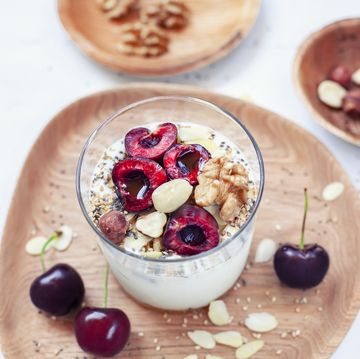Figuring out what to eat before a long run can be tricky. Not getting enough nutrition can leave you feeling sluggish and slow, and hitting that wall too soon. On the other hand, eating too much before a long run can cause cramping, uncomfortable fullness, and other gastrointestinal problems that aren’t fun to contend with while running.
So what should you eat before a long run for optimal performance? And when should you eat before you head out? We answer all your questions about what to eat before a long run, including why it’s so important to do so and why it takes some trial and error to figure out what works best for you and your body.
Why should you eat before a long run?
Susan Paul, exercise physiologist and program director for the Orlando Track Shack Foundation says eating before a long run provides two very important functions. “One, it gives you some blood sugar, which is much needed after a night of sleeping and fasting. Think of it as filling up the gas tank of your car—it’s not completely empty, but you want to top it off,” she explains.
Another important function of eating prior to a long run is that it keeps you comfortable. Paul explains that digestion can be challenging during runs because the body diverts blood flow away from internal organs and shunts it to the large muscles of the body in order to supply them with oxygen-enriched blood to meet the demands of running. The result is that areas like the gastrointestinal tract receive less blood flow during exercise.
Food present in the stomach, however, recruits blood flow for digestion, and with additional blood flow present, the stomach and GI system will be able to retain blood flow when the shunting process from running happens, keeping the GI system in better working order, Paul says.“When no food is on board, blood flow is immediately diverted away. The GI system shuts down, making eating on the run very difficult,” she adds.
“The amount of blood flow that is diverted away from internal organs is usually correlated to the intensity of the exercise. In addition, the longer the run, the more time these organs receive less blood flow, which can contribute to GI issues on long mileage days,” Paul says.
When and how much should you eat before a long run?
It’s not as simple as grabbing a bagel and lacing up. Paul recommends eating about one to two hours before the run. “Low-fat and low-fiber foods are the best choices for most runners, but experimenting with different foods is important so you can figure out what works best for you. The goal is that by race day you will have your personal nutritional plan all figured out,” she says.
Starla Garcia, RD, dietitian and Olympic trials runner based in Houston, Texas recommends fueling with 50 to 90 grams of carbohydrates for runs longer than 60 minutes. “Runners can adjust for this as well by calculating 1 to 4 grams of carbohydrates per kilogram of body weight,” she says. For example, Garcia says a 140-pound runner who has a two-hour or longer run on the schedule will need roughly 63 to 254 grams of carbs before the run. Paul also says a prerun breakfast should contain at least 200 to 300 calories.
Start with the lower end of the calorie and carb range (if you’re not used to fueling prior to running) and gradually increase it as needed. “Better to go minimal first than to overload the system,” Paul says. “Think small meals that contain primarily easily digestible carbohydrates with some protein—about a 3:1 ratio of carb to protein works best.”
What should you eat before a long run?
Garcia says if you’re short on time, consider a simple carbohydrate option like a sports gel and sports drink combination to get yourself hydrated and fueled within 30 mins of your running time.
If you’re running later in the day and have more time to digest, Garcia recommends that runners aim for a meal or snack that meets their carb needs (as a reminder, that’s 1 to 4 grams of carbs per kilogram bodyweight). Prioritize a full breakfast and/or lunch if your run is much later.
As for what exactly to eat, Garcia suggests avoiding foods like cruciferous vegetables, high-fat foods, or fried-food options to avoid GI distress, and stick with those simple carbs and a little protein instead.
Some examples of what to eat before a long run, as recommended by Garcia:
- 4 graham crackers, 1 banana, and 1 scoop of sports drink
- 1 packet of Belvita crackers and banana + 1 serving of sports drink
- 2 slices of toast with nut butter + 1 banana
- 1 cup oatmeal cooked with 1 banana and 2 tbsp of maple syrup
- 2 Pop Tarts with 1 serving of sports drink
What about hydration?
Now that you know how to fuel, you can’t forget hydration. Garcia says to drink between 8 to 12 fluid ounces of water 30 to 60 minutes prior to running. Because we all know that chugging water before you head out the door isn’t going to end well, make sure to sip slowly. “Drinking too much water can cause sloshing or cramping to occur,” she says.
Garcia adds that consuming some electrolytes in your fluids for longer training sessions are a good choice to help improve gut absorption and heat tolerance. “It can also be beneficial during cold, winter months as runners may not sweat but also still need electrolytes to help recovery,” she says. “Runners can also consume electrolytes prior to exercise to help prevent dehydration and prevent starting a run dehydrated.”
When and what should you eat during a long run?
The minimum amount of fuel you should take in per hour while running is 30 grams of carbs, Garcia says. The maximum is about 90 grams of carbs per hour. But these numbers can vary depending on your body, intensity, timing, how you feel, and more. “Depending on the type of fuel option a runner choses, the recommended time to implement or add fuel will vary,” Garcia adds.
It’s smart to ingest your fuel in increments to help you achieve 30 grams (or more) per hour. That means you’ll need to be ingesting a little fuel at a time, say every 15 to 25 minutes or so, after the first half hour.
“Typically for marathons, most runners can tolerate a gel every 30 minutes,” Garcia says. “I would recommend moving to [taking in fuel] every 20 minutes [if you can tolerate it] to get closer to the 90 grams per hour.”
Jennifer Acker joined the editorial staff of Runner's World and Bicycling in January 2022. A former freelancer writer and NCAA runner, she started running as a kid and basically never stopped. She also loves outdoor adventures, like hiking, skiing, and mountain biking.













